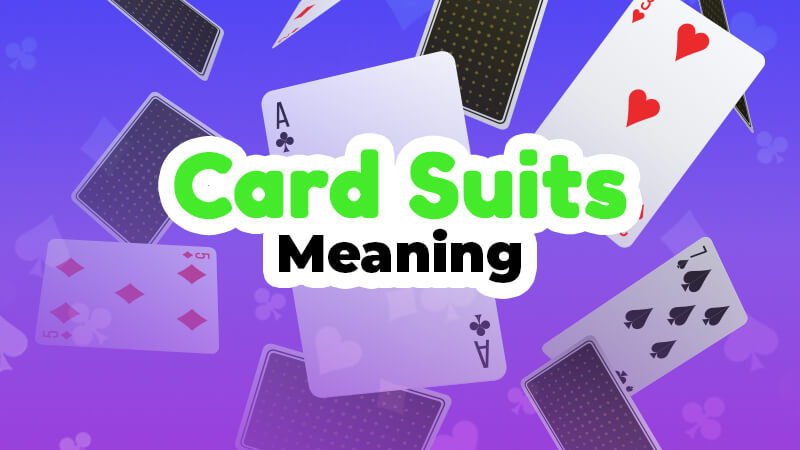Playing cards symbols meaning

Table of Contents
Playing cards have been influenced by various regions and time periods. The exact origins of playing cards and their suits are not definitively known, but they have evolved over time into the familiar forms we recognize today. Early European cards featured four suits, which correspond to the four suits in modern decks: hearts, diamonds, clubs, and spades.
In this article, we will explore the rich history and symbolism of these iconic playing card symbols.
History of the Playing card suits
Playing cards and their suits have evolved over time, with variations in design and interpretation. Different countries and regions have developed their own styles and adaptations of playing cards, contributing to the rich history of the suits.
The earliest known playing cards are believed to have originated in China during the Tang Dynasty (618-907 AD). These cards featured various suits, including coins, strings of coins, myriads, and tens of myriads. The suits represented currency denominations and were used for gambling and entertainment.
Playing cards reached Europe through various trade routes and cultural exchanges, likely arriving in the late 14th century.
European card makers standardized the deck to feature four suits: hearts, diamonds, clubs, and spades. These suits were based on earlier designs but became stylized and simplified. The hearts and diamonds represented the upper classes, while the clubs and spades represented the lower classes.
The symbolism and interpretation of the suits can vary across cultures and time periods. While the suits have functional roles in card games, they have also been associated with broader themes, such as love, wealth, growth, conflict, and transformation.
Club Symbol Meaning
The clubs suit, often referred to as “Clovers” in French, boasts a range of interpretations deeply rooted in its historical evolution. Influenced by earlier German suits known as “Acorns,” the club symbol carries varied meanings depending on the cultural context:
Growth and Agriculture: The distinctive trefoil or three-leaf clover shape associated with the club symbol lends itself to interpretations linked to growth, agriculture, and crop cultivation. This perspective underlines the significance of the natural world and the cycles of life.
Warfare: In specific regions and historical periods, the club symbol has been linked to themes of warfare and weaponry. This connection may arise from its resemblance to a mace or truncheon, symbolizing the challenges and conflicts encountered in life.
Symbol of Authority: In alternative contexts, the club symbol is viewed as a representation of authority and power, akin to a scepter or an emblem of leadership. This interpretation underscores the vital role of leadership and control in various aspects of life.
Diamond Symbol Meaning
The diamond symbol primarily serves as a functional suit for game mechanics, and any deeper symbolism is largely a matter of personal or cultural interpretation.
Here are a couple of common interpretations:
Wealth and Materialism: The diamond symbol is often associated with wealth, prosperity, and material possessions. This interpretation may be because the diamond shape resembles a cut gem or precious stone. In this context, the diamond symbol represents financial matters, success, and the pursuit of material gain.
Success and Fortune: Some people see the diamond symbol as a representation of success and good fortune. Just as diamonds are valued and sought after, the diamond symbol can be seen as a positive sign, indicating favorable outcomes or opportunities.
Heart Symbol Meaning
The heart card symbol is often associated with matters of the heart, emotions, love, and affection. It is a symbol that carries a strong sense of emotional significance. While the heart symbol itself does not have a universally fixed or intrinsic meaning, it has come to represent a range of themes, including:
Love: The heart symbol is most commonly associated with romantic love. It is often used to convey affection, passion, and romantic connections between individuals. In the context of playing cards, it can represent the emotional bonds and relationships that people share.
Emotions: Hearts also symbolize a broader spectrum of emotions, not just romantic love. They can represent compassion, empathy, friendship, and the depth of human feelings and connections.
Spirituality: In some interpretations, the heart symbol is seen as a representation of the spiritual or metaphysical realm, symbolizing the soul or the core of one’s being.
The red color of hearts, often depicted in a deep shade of red, is emblematic of warmth and passion, reinforcing the idea of love and strong emotions.
Spade Symbol Meaning
The spade card symbol in a standard deck of playing cards is often associated with various themes, including:
Conflict and Struggle: The spade symbol is frequently linked to conflict, struggle, and challenges in life. Its sharp, pointed shape is reminiscent of a weapon or a tool used for digging or excavation. This association suggests the idea that life involves difficulties and the need to overcome obstacles.
Transformation: In some interpretations, the spade symbol represents transformation or change. This can be seen in the context of digging and excavation, as well as the idea that significant changes often require breaking through barriers and old ways of thinking or being.
Power and Authority: The spade symbol is sometimes associated with power and authority. The pointed shape can be seen as a symbol of strength and leadership. This interpretation suggests that the spade represents the capacity to make significant changes and exert influence.
The black color of spades, often depicted in a deep shade of black, adds to the sense of seriousness and mystery associated with these themes. Its symbolism contributes to the complexity and depth of meaning in a standard deck of playing cards.
Subscribe now
Receive updates and latest news about VIP Games. Simply enter your email below and get notified!
You will only receive quality content.
Signing up for newsletters indicates you agree with our Privacy Policy. If you decide that you no longer want to receive a newsletter, you can unsubscribe by clicking the “Unsubscribe” link, located at the bottom of each newsletter.
